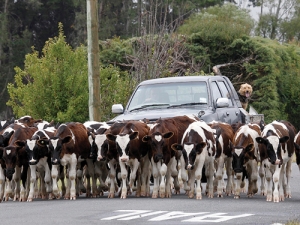University of Waikato research reveals 2050 drought threats
New research could help farmers prepare for a future where summer rainfall is increasingly unpredictable and where drought risk is rising, no matter what.
 North Canterbury farmer Emmet Daly moving some of his calves down Mina Road, near Cheviot, last week to a paddock with more feed as a light drizzle fell throughout the district.
North Canterbury farmer Emmet Daly moving some of his calves down Mina Road, near Cheviot, last week to a paddock with more feed as a light drizzle fell throughout the district.
"Everyone's trying all sorts of combinations to get through" is how Cheviot's Emmet Daly describes North Canterbury farmers' efforts to cope with their sixth season of drought.
The 50mm of rain that fell January 2 was a huge morale booster for the locals, says Doug Archbold, chairman of the North Canterbury Rural Support Trust. He knows of several farmers who sat looking out the window watching the rain; at least one went out and danced in it.
The rainfall exceeded falls in the first seven months of 2015, giving new life to brassicas, rapeseed and kale and helping lucerne crops.
NIWA's latest soil moisture deficit map shows a dire water situation in North Canterbury: the moisture deficit in some parts of the district is at least 130mm in the red.
Archbold says there is quite a variation in the Hurunui district: Scargill, Waikari, Hawarden and the Leamington valley are "very, very dry," but some coastal areas are average for rainfall.
Rainfall data from a new NIWA monitoring station near Medbury indicates the area is within 10-15ml of the driest year on record. This all points to the worst drought in 20 years, possibly becoming the worst since records began.
But the news is not all bad: Archbold says sterling work by Beef + Lamb NZ in holding numerous info days has enabled farmers to make early decisions. Those who made early tough decisions have come through well.
Toughest of all has been on de-stocking – especially capital stock. Archbold says a huge de-stocking of beef cattle around the Hurunui has had a big impact.
Driving around the district it is starkly obvious how much de-stocking has occurred: paddock after paddock is bare of feed and stock. And in several cases the animals remaining are already reliant on supplementary feed.
Daly, discussing his own efforts, says he had reduced his stock numbers by 300 ewes and increased his crops in an effort to cope, but highlights poor yields from some of his crops.
He says the money's not there for farmers and there will be big financial headaches for people when they need to restock.
Archbold also points to the financial implications of such a long drought and he praises the banks for being supportive.
However, the hottest month of the year is still to come and the next six months will be crucial for farmers and banks. Hopefully they can hold their nerve as the weather changes from El Nino to a La Nina cycle and the prospect of rain.
Westpac NZ has announced new initiatives that aim to give customers more options to do their banking in person.
New Zealand red meat exports experienced a 29% increase year-on-year in September, according to the Meat Industry Association (MIA).
The head of the Ministry for Primary Industries (MPI) biosecurity operation, Stuart Anderson, has defended the cost and the need for a Plant Healht and Environment Laboratory (PHEL) being built in Auckland.
BNZ says its new initiative, helping make the first step to farm ownership or sharemilking a little easier, is being well received by customers and rural professionals.
The head of Fonterra's R&D facility in Palmerston North is set to literally cross the road and become the new vice chancellor at Massey University.
Allan Freeth, chief executive of the Environmental Protection Authority (EPA) has announced he is resigning.